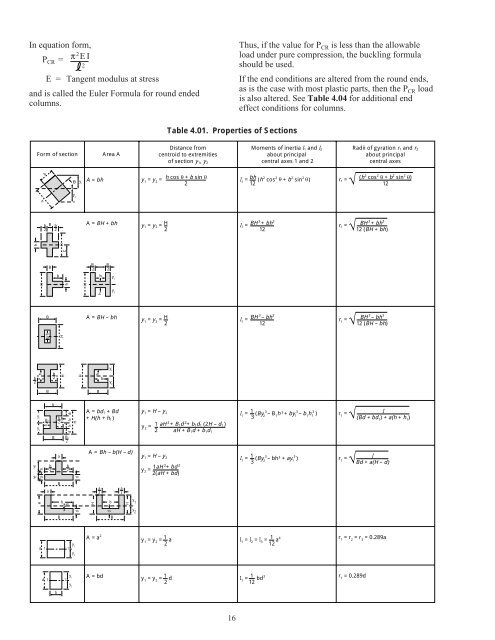General Design Principles for DuPont Engineering Polymers - Module
General Design Principles for DuPont Engineering Polymers - Module
General Design Principles for DuPont Engineering Polymers - Module
You also want an ePaper? Increase the reach of your titles
YUMPU automatically turns print PDFs into web optimized ePapers that Google loves.
In equation <strong>for</strong>m,<br />
P CR = π2 E I<br />
2<br />
E = Tangent modulus at stress<br />
and is called the Euler Formula <strong>for</strong> round ended<br />
columns.<br />
h<br />
b<br />
2<br />
y1<br />
y2<br />
Form of section Area A<br />
h<br />
b<br />
H<br />
h<br />
y 1<br />
y 2<br />
d h<br />
H<br />
b<br />
2<br />
B<br />
h<br />
b<br />
B<br />
B<br />
b<br />
2<br />
b<br />
2<br />
b<br />
H<br />
H<br />
C<br />
H<br />
h<br />
θ<br />
y 2<br />
y 1<br />
H<br />
H<br />
B<br />
2<br />
B<br />
2<br />
b y1 h<br />
h<br />
B B<br />
B1<br />
2<br />
a<br />
b<br />
2<br />
b<br />
B<br />
b<br />
2<br />
a<br />
B<br />
b<br />
d h h1 d1<br />
H<br />
B1<br />
2<br />
b<br />
2<br />
h<br />
a 1 1<br />
d<br />
d<br />
A = bh y 1 = y 2 =<br />
A = BH + bh<br />
b<br />
y 1<br />
y 2<br />
y 2<br />
A = BH – bh<br />
A = bd1 + Bd<br />
+ H(h + h1 )<br />
A = Bh – b(H – d)<br />
H<br />
a<br />
2<br />
B B<br />
A = a 2<br />
b<br />
d<br />
y1 = y2 = H<br />
2<br />
y 1 = y 2 = H<br />
2<br />
y 1 = H – y 2<br />
y 1 = y 2 = 1 a<br />
2<br />
Table 4.01. Properties of Sections<br />
h cos θ + b sin θ<br />
2<br />
y 2 = 1 aH 2 + B1d 2 + b1d1 (2H – d1 )<br />
2 aH + B1d + b1d1<br />
y 1 = H – y 2<br />
Distance from<br />
centroid to extremities<br />
of section y1, y2<br />
y 2 = 1aH 2 + bd 2<br />
2(aH + bd)<br />
y<br />
1 A = bd<br />
d 1 1 y1 = y2 = 1 d<br />
2<br />
b<br />
y 2<br />
y 1<br />
y 2<br />
a<br />
2<br />
H<br />
y 1<br />
y 2<br />
16<br />
Thus, if the value <strong>for</strong> PCR is less than the allowable<br />
load under pure compression, the buckling <strong>for</strong>mula<br />
should be used.<br />
If the end conditions are altered from the round ends,<br />
as is the case with most plastic parts, then the PCR load<br />
is also altered. See Table 4.04 <strong>for</strong> additional end<br />
effect conditions <strong>for</strong> columns.<br />
Moments of inertia I1 and I2<br />
about principal<br />
central axes 1 and 2<br />
I 1 = bh (h 2 cos 2 + b 2 sin 2<br />
12<br />
I1 = BH 3 + bh 3<br />
12<br />
I 1 = BH 3 – bh 3<br />
12<br />
I 1 = I 2 = I 3 = 1 a 4<br />
12<br />
θ )<br />
I 1 = 1 (By 3 –B 1 h 3 + by 3 – b 1 h 3 )<br />
3 2 1 1<br />
I 1 = 1 (By 3 –bh 3 + ay 3 )<br />
3 2 1<br />
I 1 = 1 bd 3<br />
12<br />
θ<br />
r1 = √ (h2<br />
cos 2 θ + b θ<br />
2 sin 2<br />
)<br />
12<br />
r1 = √ BH 3 + bh 3<br />
12 (BH + bh)<br />
r 1 = √ BH 3 – bh 3<br />
12 (BH – bh)<br />
r1 =<br />
I<br />
√(Bd<br />
+ bd1 ) + a(h + h1 )<br />
r 1 = √<br />
Radii of gyration r1 and r2<br />
about principal<br />
central axes<br />
I<br />
Bd + a(H – d)<br />
r 1 = r 2 = r 3 = 0.289a<br />
r 1 = 0.289d

















